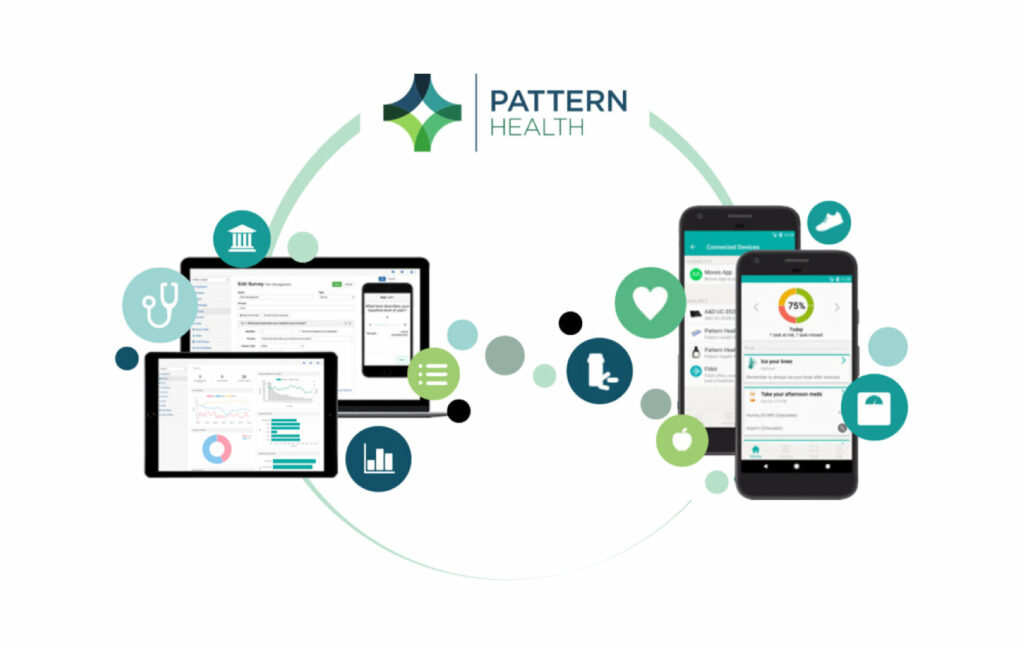
When a healthcare system or pharmaceutical company wants to create a digital health tool, whether a mobile health patient app, clinical decision-making tool, or a remote patient monitoring system to collect research data from wearables or remote sensors, often the first inclination is to look for an app developer. While researching app developers, the interested person will look for developers experienced with HIPAA compliance that can connect and integrate with wearables and other health data sources through Bluetooth, Google Fit, Apple Health, or electronic health record (EHR) systems. They might also seek a developer who has experience working with Apple’s ResearchKit and CareKit frameworks.
In 2021, though, using custom app developers is rarely the best approach. The industry has advanced enough that healthcare systems and others can create high-quality, sophisticated digital health programs using rapid “no-code” platforms. They don’t need to hire developers who must start from scratch. In much the same way that non-technical people can create websites using templates with drag and drop elements, no-code app technology allows people to create healthcare apps quickly and without high development costs.
Of course, digital health app development firms do still exist, and they’re a good option to use for specific use cases. But for the majority of healthcare apps, it is simply too expensive, time-consuming, and risky to build a custom app, rather than building on a no-code platform.

What is a No-Code Platform?
It’s a website interface that enables the creation of apps using easy drag-and-drop-type tools. No app developers are needed since there’s no programming or coding involved. You can create, configure, and manage the digital health program through an easily understood interface. At Pattern Health, we call ours the Pattern Console. To create your app, you work closely with our program management team and subject matter experts in a structured, collaborative process that’s easy, fun, and designed to ensure that your digital health program is a success. Our program management team takes care of all of the setup, configuration, and ongoing support.
Using a no-code platform is advantageous over custom development for a number of reasons, including the cost, time, and risk involved.
How No-Code and Custom Apps Differ
When thinking about creating a healthcare app, it helps to look at some of the bigger picture issues, such as budget, timing, and maintenance plan. Here’s how a no-code platform like Pattern Health’s compares to custom developers.
Cost to develop the app:
Prices to create a custom mobile health app range widely. Research 2 Guidance pegs development costs – only up to the launch – at $425,000 on average. And this was the cost several years ago. They projected that costs would increase. These costs don’t include maintenance or additional post-launch development. Conversely, most Pattern Health customers pay less than $3,000 a month to license the platform plus a small one-time setup fee. Those with highly complex programs or those serving a higher volume of users do pay more in absolute terms, but proportionately, it is an efficient exchange. Compare the $425,000 to develop an app (but not maintain it), to less than $36,000 a year. It’s a big difference — more can afford to use a no-code platform. Even if the Pattern Health app is used for a decade, it still doesn’t reach the cost just to launch the custom app.
Reinventing the wheel:
App developers reinvent the wheel for each custom application. With a healthcare app, they may need to integrate with the organization’s EHR, provide log-in modules with accounts/profiles, incorporate communication channels including APIs to third parties, and add other administrative and analytics features. The app must address security, compliance, and privacy. Pattern Health has many functionalities already built into the platform, often used for patient research and data collection purposes, to support chronic conditions, perioperative care, wellness, and other conditions. And of course, security, compliance, and privacy are at the top of every list.
Time to develop the app:
The Research 2 Guidance report found that developing a standard digital health app took 12 to 24 months. And again — that’s only up to the launch point. Most mobile health apps need additional development after launch, plus maintenance. If used for research, that is a year or two without collecting digital data. With Pattern Health’s no-code platform, many organizations have an app up-and-running in less than six weeks. Repeated again, less than six weeks. That allows the organization to configure and launch its digital health programs quickly and efficiently.
Barriers to launching the app within a healthcare system:
Deploying a digital health app within a health system is a lengthy process involving legal agreement negotiation, IT systems integration, and information security audits that can easily take an additional six to 12 months. If you’re using a no-code platform that’s already deployed and approved in the health system environment, this step is much simpler and faster. For a no-code platform like Pattern Health that has a network of relationships already established, there is a powerful multiplier effect to the time saved when scaling deployment of a digital health tool across multiple organizations.
Maintaining the app:
The app will likely need additional development and maintenance. An app developer continues charging for that, if they provide maintenance at all (some don’t). Organizations that use app developers need to plan for this in their budget or find human resources to do it, like its own staff members. Maintenance is not just for the app content. It is also ensuring that the application complies with newly released OS and Windows versions, security patches, and updates.
In rare cases, it is better to build your own application rather than use a no-code platform. But most academic and pharmaceutical research using an app can be completed with platform capabilities. Pattern Health’s no-code, modular platform can easily grow and scale to meet the needs of a wide range of researchers, like using the same digital care program in research and clinical practice. Making these changes, if needed, requires a fraction of the time and cost custom solutions would require. The Pattern Health platform model supports the full innovation life cycle by facilitating the translation of research into practice, from research studies to clinical use and commercialization.
To learn more about how your academic medical center, healthcare organization, or pharmaceutical company can benefit from a no-code app platform in the digital health realm, contact Pattern Health.